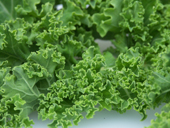
UK/Ireland
•Canada/USA
________________________________________________________________________

eat
kale
Kale is a very handy
ingredient for seasonal eaters as it is one of the few green vegetables
that is more abundant and flavorful during the coldest months of the year.
It can be substituted for cabbage or spinach and makes a fine side dish
when blanched and sautéed with garlic (a little soy and a sprinkling
of chopped, roasted nuts is a lovely addition). It also makes an excellent
ingredient in hearty, warming soups such as Scotch Broth and
the traditional Portuguese dish Caldo Verde (see PICK OF THE
RECIPES).
HISTORY
Kale has been cultivated for over 2,000 years. In much of Europe it was the most widely eaten green vegetable until the Middle Ages when cabbages became more popular. Historically it has been particulary important in colder regions due to its resistance to frost. In nineteenth century Scotland kail was used as a generic term for 'dinner' and all kitchens featured a kail-pot for cooking.
BIOLOGY
A member of the same family as the cabbage - Brassica oleracea - most of the kale eaten in this country is curly leaved and belongs to the species acephala. Flat leaved kales are also grown but tend to be tougher and are now used mainly for animal feed.
NUTRITION
Kale is a nutritionally rich food containing:
-
vitamins A, C and E
-
a substantial mineral content including manganese, iron, calcium and potassium
-
phytochemicals such as sulphoraphane (linked to cancer prevention)
TIPS
BUYING
Kale should have a fresh green color with moist, crisp, unwilted leaves.
Young, small-leaved specimens are more tender; bigger leaves are well
suited for use in soups.
STORING
Keep in a plastic bag in the fridge. Kale becomes increasingly bitter
and strongly flavored the longer it is kept and so is best eaten soon
after buying.
PREPARING
Give kale a good wash in a sinkful of water to remove any dirt clinging
to the inside of the leaves. If the stems are very small and tender they
can be cooked with the leaves. Stems that are thicker, but still tender,
can be cut off and cooked for a minute or two before the leaves are added.
Any thick, tough stalks should be discarded.
Kale has a relatively low moisture content and therefore does not shrink as much as other greens and requires a longer cooking time. Except when very young, kale is not particulary pleasant when undercooked and should be served soft rather than al dente. Steam, simmer or saute gently for several minutes until thoroughly tender. A stock can be added for extra flavor.
OTHER STUFF
Early in the twentieth century, Kailyard (kale field) was a disparaging term used to describe a school of Scottish writers, including Peter Pan author J. M. Barrie, whose writing featured sentimental nostalgia for rural Scottish life.
PICK OF THE RECIPES
in
season:
january
february
march
april
may
june
july
august
september
october
november
december
main regions:
Canada and Northern USA
ONLINE
IN PRINT
-
Smoked Haddock Cakes with Poached Eggs and Curly Kale
The Complete Cookery Year -
Kale and Chestnut Soup
The River Cottage Year -
Kale with Chorizo and Poached Egg
How to Eat: The Pleasures and Principles of Good Food


